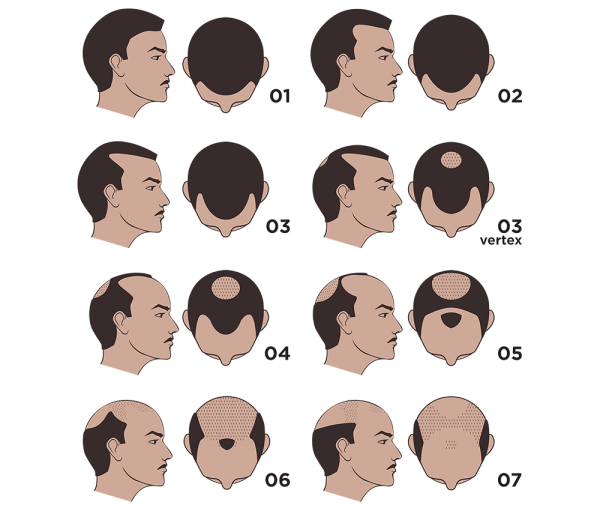Why is early treatment for hair loss important? Though regrowth is possible, it’s much easier to maintain a full head of hair with over-the-counter and/or prescription-grade options when you have hair to begin with.
So keep in mind, early intervention is key.
Hair loss is more common among men than women – and it’s often more obvious. In fact, male pattern baldness, or androgenic alopecia, affects as much as 50% of the male population at some point in their life. The issue for most is genetic.
Call it the great hair genetic coin toss.
Androgenic alopecia is a genetic condition – the leading cause of hair loss for men – that makes hair follicles more susceptible to androgen hormones. Androgen hormones are “sex” hormones, like testosterone and estrogen. Dihydrotestosterone (DHT) is the most potent of these, and it actually comes from testosterone, when it is converted by an enzyme called 5-alpha reductase. The role of this enzyme and DHT is so significant in hair loss that one of the most effective hair loss treatments ever approved by the FDA, finasteride, actually works by shutting down the 5-alpha reductase enzyme.
Due to increased exposure to DHT over time, men with androgenic alopecia will experience shrinking hair follicles that eventually lose the ability to produce hair.
In general, men’s hair loss treatments work by slowing and preventing the damage that androgenic hormones, like DHT, do to your hair follicles.
Here’s what you should look out for:
Your family. Take a look at your dad, mom, brothers and sisters: if their hair is thinning, there’s a good chance you’ll join them too. Androgenic alopecia is genetic. While the genetics still aren’t fully understood, baldness on either side of your family typically is a telltale sign. This is one of the first and earliest warning signs of possible hair thinning.
Hair in the drain or in your comb. Are you seeing more hair in your shower drain or in your comb? While it’s normal and healthy to lose some hair during daily grooming – as much as 100 hairs daily – any more, and it can be sign of hair loss in progress.
A receding hairline. Hair loss in men usually starts with a receding hairline. Check to see if you have a more pronounced widow’s peak with the tell-tale “M” shape.
Diffuse thinning, or thinning at the crown. Hair loss can also begin at the crown or top of your head. Because this is a hard spot to see, consider taking photos of the top of your head periodically so you have a reference point and can spot changes over time.
The Norwood scale is a visual diagram used by dermatologists to categorize your stage of hair loss. It can be helpful in understanding where you fall on the spectrum of hair loss, and it may help you and your doctor understand the best treatment options.
Common problem areas for men, as you can see, are the frontal hairline and the crown. Following this scale, there are seven stages of balding, ranging from no balding whatsoever to completely bald.

Some solutions are known to help regrow lost hair, but as you can expect, it’s far easier to strengthen and maintain productive hair follicles.
Finasteride and minoxidil (known as Propecia® and Rogaine® originally) are FDA-approved medications proven to prevent, slow, and possibly reverse hair loss. They’re affordable and easy to use, and millions of men have found safe effective relief with these medications.
But remember, early treatment for hair loss works best. Retaining your existing hair is much easier than growing new hair, so pay attention, and get help early. Shapiro MD can help with a telemedicine visit, prescription solutions, and over-the-counter solutions you can count on.




